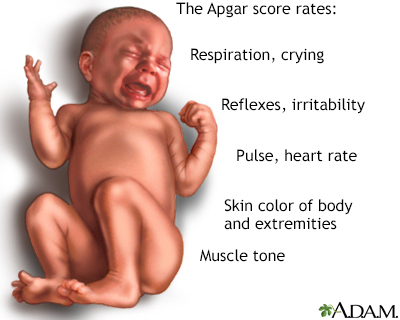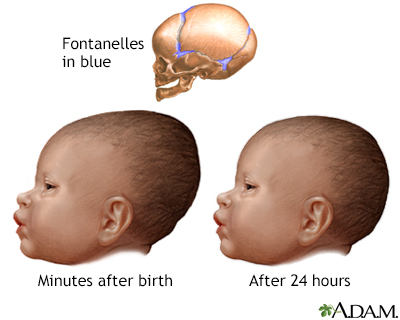Pregnancy SmartSiteTM
Your Baby's First DayYou've been waiting in excitement for the day when you can actually meet the baby you've been carrying for nine months - and the day has arrived. You are the proud parents of a new baby! What happens now? Immediately Following DeliveryAs soon as your baby's head is delivered, the mouth and nose will be suctioned so the baby can breathe easier. The baby will start to breath on its own and will become pink. Other procedures will begin the minute you deliver.  The first is an APGAR score to assess your baby's health at 1 minute and then again at 5 minutes. The purpose of this test is to measure the baby's condition in five areas:
Each area is assigned a number from 0 to 2. The APGAR score is the total of those numbers. Most babies score between 7 to 10. Most newborns will be assigned a 1 for skin color rather than a 2. It is normal for newborns to have slightly bluish hands and feet initially after birth. If the score is lower than 7, the baby may need some extra help making the transition to life outside your uterus. APGAR is a good tool to assess how the baby is doing at the time of birth, but it does not necessarily show how well the baby did before birth or how it will do in the future. The umbilical cord will be clamped and cut after the baby is delivered. There will be a remaining stump that shrivels and falls off within 7 to 10 days. It is important to keep the cord area clean to avoid infection. Other procedures that will go on right after birth include:
These procedures generally happen sometime during the first hour after the baby is born. If your baby is crying and healthy, you can probably hold her immediately after she is born. Your nurse will help dry her off, and then place her directly on your chest, with a blanket over both of you to keep her warm. Other mothers prefer to have their baby cleaned off and bundled in a blanket before they meet her up close. Let your labor nurse know what feels most comfortable to you. Babies are often alert and interested in breastfeeding in the first hour after there are born. Ask you labor nurse or health care provider to help you and your baby figure out how to latch on so that he can get some colostrum. This is the watery liquid your breasts make in the first few days after birth. It's especially designed to protect your baby from infections. What Happens To The Baby?At some point in the first day or two, the baby will be given a bath and an injection of Vitamin K to help her blood clot normally. It is likely the baby will also receive a dose of hepatitis vaccine, depending on the doctor's recommendations. Other tests that will be done within 48 hours include blood tests for some rare but serious diseases, including PKU (phenylketonuria) and congenital hypothyroidism. The blood is taken from the baby's heel. A nurse or physician will also do a general newborn assessment of the baby. The rest of the time, a healthy baby can stay in your room where you can gaze into each other's eyes and get to know each other. Some mothers opt to have their babies sleep in the nursery at night, but it's worth knowing that studies show moms and babies sleep better when they are in the same room. See how you feel after delivery and decide what will work best for you. Baby's AppearanceSome new parents are surprised by the way their baby looks right after birth. The reason is that television and magazines usually show babies that are 1 to 3 months old as being newborn. Most of the things you may notice will disappear within a few days or weeks after the baby has adjusted to its new environment. Counting fingers and toes is common for most parents.  Remember, your tiny baby has just taken a difficult journey from being inside your body to the outside world. As a result, your baby will be wet and have a slightly pointed head after passing through the birth canal. There are two soft spots on the baby's head where the skull bones have not completely grown together yet. These stay flexible for about 6 months, and then the skull will harden. The baby's arms and legs will appear "scrunched up" because they were positioned that way in the uterus. The baby's face and genitals may look swollen. Some babies have a greasy, whitish coating (vernix) that protected their skin from the constant exposure to amniotic fluid. You may also see fine hair (lanugo) on the baby's back, ears, and shoulders. It will disappear in days or within a week. You may notice little white spots or blotches on your baby's skin, and the skin may look delicate and wrinkly. These are nothing to be concerned about. All of these things will disappear within a week or two (and the baby will continue to change on a day-to-day basis). Baby's BehaviorIt is not unusual immediately after birth for babies to be alert. Your baby may hold onto your finger with his tiny hand and he may also want to try breastfeeding. Some babies are quiet and calm while others may cry intensely. Within about the first hour, your baby will want to sleep (short naps for short periods of time). Some babies don't sleep as much as others. This is where the uniqueness of your baby begins. If It's A BoyIf you have a baby boy, you will be asked about whether you want your son to have a circumcision performed before you leave the hospital. A circumcision is the surgical removal of the foreskin of the penis. It is most often done within 1 to 2 days after birth. This is your decision, so you may want to think about and discuss this matter before your delivery. | ||
| ||
Review Date: 8/20/2019 Reviewed By: LaQuita Martinez, MD, Department of Obstetrics and Gynecology, Emory Johns Creek Hospital, Alpharetta, GA. Also reviewed by David Zieve, MD, MHA, Medical Director, Brenda Conaway, Editorial Director, and the A.D.A.M. Editorial team. View References The information provided herein should not be used during any medical emergency or for the diagnosis or treatment of any medical condition. A licensed medical professional should be consulted for diagnosis and treatment of any and all medical conditions. Links to other sites are provided for information only -- they do not constitute endorsements of those other sites. No warranty of any kind, either expressed or implied, is made as to the accuracy, reliability, timeliness, or correctness of any translations made by a third-party service of the information provided herein into any other language. © 1997- A.D.A.M., a business unit of Ebix, Inc. Any duplication or distribution of the information contained herein is strictly prohibited. | ||



